We were up at 4:00 a.m. for an early breakfast and a ride to the airport. During the flight we saw a few cracks in the clouds, and below them, some of the snow-capped peaks of the Himalayas.
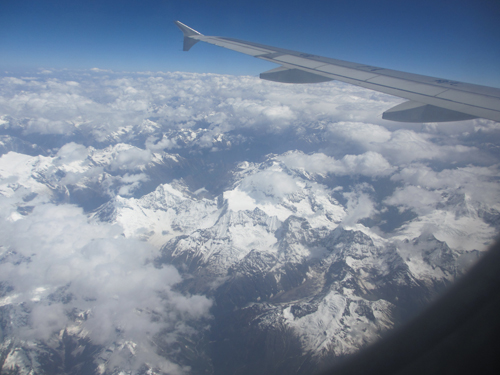
From the Lhasa airport to the town itself is a 60 mile ride on a good road. The scenery is very interesting. We followed the course of the valley created by the Kyichu River (sometimes referred to as the Lhasa River, or with different spellings). All along the river valley farmers were in the fields working on their crops. The amount of agricultural production at this high altitude was surprising. The green of the valley contrasted sharply with the brown of the bordering, treeless mountains. The river is wide and fast. Along the way I saw some Brown-headed Gulls and Common Terns working over the water.
Tibet was absorbed by China in 1950. It is designated as an Autonomous Region, rather than as a Province. Before then it was virtually inaccessible from anywhere.
There are now 3 ways to reach Lhasa: by air, by train or by highway. The advantage of air travel is solely the time saved. Among the disadvantages are inability to see the great scenery that could be seen from a train or a motor vehicle, and the altitude sickness often incurred upon arriving abruptly at 12,000 feet. Fortunately, we all had taken altitude sickness pills. This worked well for me (I have never had a problem with altitude sickness anyway) and several of the others, but Barbara had some adverse effects the first day, until she increased her dosage. Our guide, Michael, suffered greatly during the whole stay, and apparently this always happens to him in Tibet.
As we approached Lhasa we stopped in a small village to visit a farm family. The husband was out working while the wife was home with a little baby. Another lady was there to help her. They lived in an old limestone structure, enclosed with “outbuildings” in a wall-like fence.
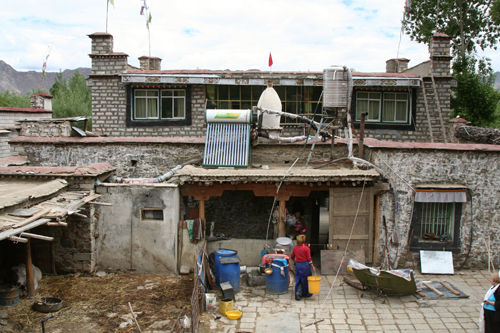
Within the compound was a barn with several cattle and chickens. Dung patties lined the top of the wall, presumably fuel for the cold nights ahead. It smelled just like the barn I remember as a boy, but much closer to the living quarters than I experienced.
Among the immediately noticeable differences in Tibet from Beijing and Xian were the features of the people and their clothing. Most of the residents of Lhasa are Tibetan, and many of them wear the traditional garb of Tibet. Many of the people looked more like American Indians than like Han Chinese. Lhasa has the feel of a very different culture. The practice of Buddhism here is obvious, whereas in Beijing and Xiang, there was almost no evidence of any religious observance.
We checked in at the Xin Ding Hotel and rested for the remainder of the day and evening. Michael had told us that the hotel wasn’t the highest rated in the city, but the rooms had the best view of the 1,000 room Potala Palace, the home of the Dalai Lamas since the 17th century. Indeed, the view was spectacular and almost made up for the deficiencies in the other amenities, like cleanliness, food, temperature control and service. At night, the Palace was lighted and presented an even more spectacular view.
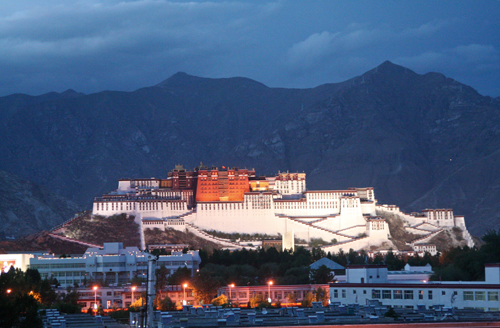
Barbara experienced a bad night with nausea and headache. I was tired. We are at 11,975 feet altitude and it definitely feels like it. The shower leaked badly so we had a lake in the bathroom.
Our first activity was go to the holiest temple of the Tibetan world, Jokhang.
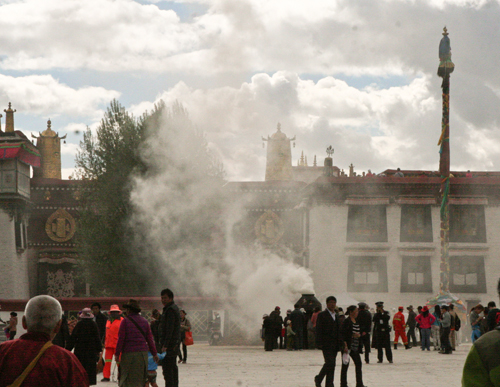
Jokhang is for Tibetan Buddhists much as Mecca is for Muslims: a visit there in one’s lifetime is essential for a happy after-life. Although Tibet is part of China politically, and is experiencing some assimilation, it still preserves an ancient culture all its own – which we began to encounter more intensely as we moved to the eastern part of the city toward Jokhang. Many pilgrims in traditional garb (which I found most attractive), were walking to the Temple. Near the doorways to the Temple, pilgrims, many quite elderly, were prostrating themselves (stand with hands together above head, come down to kneeling position, put hands, usually with protective mittens, on the ground and slide them forward until the hands are again above the head and the face is on the ground; stand and repeat).
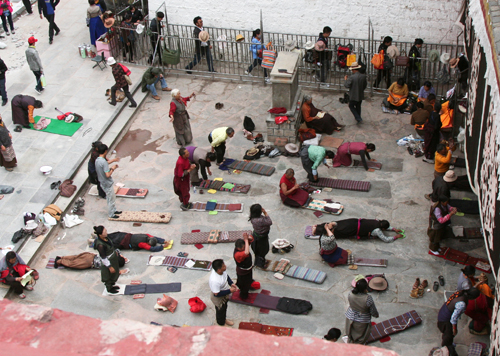
Many were spinning their golden prayer wheels.
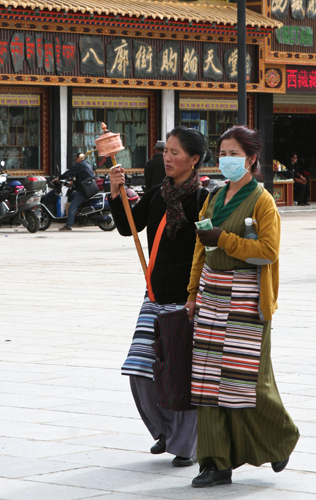
There was a giant prayer wheel outside the Temple, at which we each took our “turn”. “Incense” (from juniper branches tossed on a big fire in the square) was burning away with abandon, adding to the sensory overload. Within the Temple itself, the crowd was dense and making one’s way through required effort and ingenuity. Within, red-robed monks chanted prayers and collected money.
We climbed to the roof of the Temple, from where we enjoyed a panoramic view of Lhasa, including the Potala Palace from a different direction. We walked back a half mile or so through the Barkhor Bazaar. It was teeming with vendors of religious and other items, and with people. Lunch was at a local restaurant at the corner of the Bazaar.
In the afternoon we went to the Sera Monastery, which is more like a seminary or university than a place of worship. Once home to over 5,000 warrior “Dob Doa” monks, fewer than 500 now reside there. Many (150 or so) red-robed monks were engaged in debate in the open courtyard.
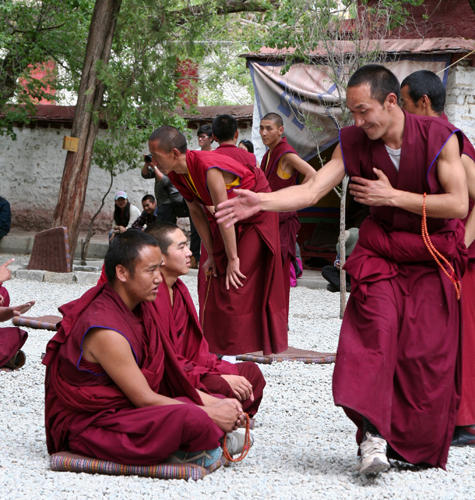
The debate is vigorous. A monk stands in front of 1-3 others who may be seated, speaking loudly and emotionally, punctuating his speech with sharp hand claps and foot-stamping lunges toward his audience. The listeners, on the other hand, maintained a fine decorum, smiling often, nodding, sometimes as if in agreement, sometimes as if not in agreement.
From the Monastery, we returned to the hotel for a couple of hours rest before dinner. The food was adequate and the dinner was accompanied with a show featuring traditional Tibetan dancers. The yak butter tea tasted fine. Tomorrow we climb to the main attraction, Potala Palace.
